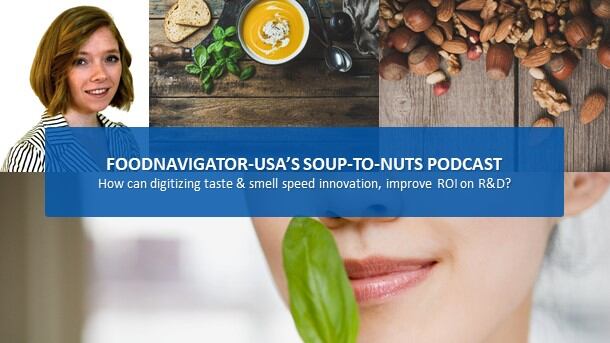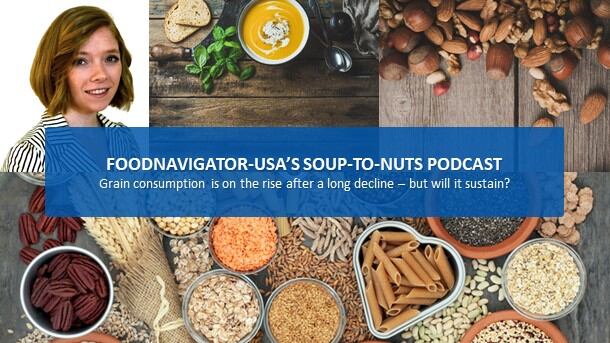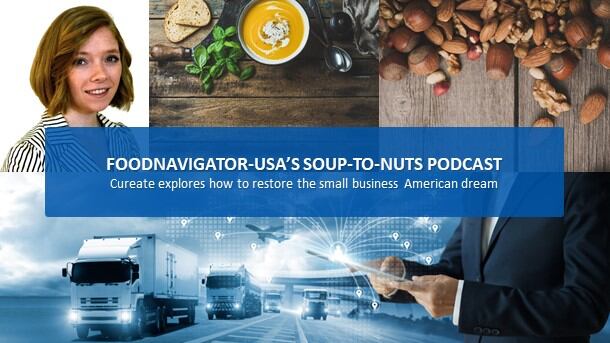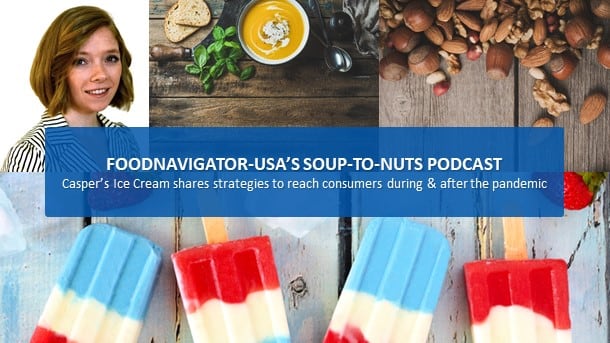The result is a staggering 80% failure rate among new CPG product launches – costing the industry billions of dollars in new product development and often completely wiping out startups or entrepreneurs who bet big on what turned out to be a bad or poorly executed idea.
But the California-based biotechnology and data science company Aromyx could help reverse these odds in innovators’ favor by using DNA and advanced robotics to digitize and quantify scent and taste so that companies can innovate faster with more reliable results.
In this episode of FoodNavigator-USA’s Soup-To-Nuts podcast, Aromyx director of product and operations Morgan Moncada explains how the company’s EssenceChip technology scientifically records flavors and fragrances and uses a proprietary AI-powered Allegory Database to analyze this data in ways that were not possible before. He shares how this combined technology is helping food and beverage companies develop better tasting products consumers want more quickly for less, improve their marketing to drive higher sales and even advance their sustainability missions.
[Editor’s note: Never miss another episode of FoodNavigator-USA’s Soup-To-Nuts podcast – subscribe today.]
Digitizing taste & smell with synthetic biology
According to Aromyx, the human nose can distinguish between a trillion different odors, but most people can’t accurately or precisely describe the difference between smells and flavors – but Aromyx can.
The company uses synthetic biology to replicate the human nose on an SBS format multi-well plate – or EssenceChip – that can be read to gauge odorant ligands bound to receptors. In this way, the sensor products capture qualitative data – such as whether something smells savory or sweet or rancid – which is then measured with algorithms to form digital signatures that can be visualized and translated into actionable insights for companies.
“It’s really just an example of this emerging industry … called synthetic biology, where we are engineering organisms in the same way that one would program a computer,” Moncada said. “So, we are engineering, essentially, a living but artificial nose.”
He explained the company engineers human taste and smell receptors into bio sensor cells that are tethered to a biochemical circuit, which allows it to test many different olfactory receptors against any order or flavor or substance.
The test results are used to create a heat map or signature that can be transformed into multi-dimensional maps of perception to create actionable insights for customers, Moncada added.
Reverse engineering the competition, speeding innovation
One way this data and technology is used in the food and beverage industry is to recreate or reverse engineer existing products, which can then be compared to prototype ‘me-too’ or used as a starting point for iterating and creating new, improved versions.
Aromyx’s technology can also help accelerate new product development and improve quality control by rapidly testing prototypes and providing quantitative sensory feedback to guide reformulation, if necessary.
The ultimate goal is to reduce product development costs and the failure rate of new products so that companies more easily can meet evolving consumer demands, for example, for healthier products that don’t compromise on smell, taste or experience.
“There is a huge, huge push to create natural, healthier alternatives that also taste better. But the problem is when they and replace the current ingredients with say, alternative plant-based protein, they’re oftentimes mal odors that are introduced – sometimes because these plant-based molecules are binding to other flavor molecules, thereby mitigating some of the good flavor, or … the plant-based molecules themselves are potentially contributing to a bitter taste or a bitter odor,” Moncada explained.
“What we do in that case is we help our customers use the receptor data to solve whatever problem they’re interested in based on their particular product,” he added.
Tailoring products for different population segments
Aromyx’s ability to account for how human genetics influence peoples’ experience of taste and smell can also help companies create product variations for different regions where preferences may vary in previously difficult to predict ways.
“A new area that we have been recently exploring that is very exciting is in this idea of receptor-genetics,” Moncada said. “Between any two individuals only, on average, 70% of the receptors are identical genetically. So, there’s a large variation in these different types of receptors both for olfactory and taste receptors.”
Aromyx can test different versions of products on different populations to help innovators create variations of products for different markets that will perform better than if they had only one version for all markets.
“An example of that is a project where we were working with beverage reformulation, and we were trying to help them essentially introduce a new alternative sweetener into their product. And what we were able to discover was a chemical mal odor that was then correlated to differences in these receptors and there was a specific variant that targeted a certain Asian group more prominently where they had a much higher signal or response to that potential mal odor,” Moncada explained.
Finetuning marketing with more accurate descriptions
Aromyx can also help companies improve marketing by selecting words that more accurately describe a product’s taste or aroma – an increasingly important factor now that in-store sampling is off the table due to the ongoing pandemic and companies must find new ways to drive trial of new products.
“There’s a huge disconnect between how companies might describe their products, and how consumers actually perceive their product. We are trying to bridge that gap,” by creating a database that connects receptor activation patters to different word descriptors that can be applied in different languages or for different products, Moncada explained.
Optimizing ingredient selection
In addition to helping drive sales and speed innovation, Aromyx can help companies reduce cost through ingredient optimization.
“This is a huge area of opportunity because what’s interesting about the receptors is they are what we call promiscuous, so they bind sometimes to many, many, many different molecules. And so that’s why it is really important to use our platform to look at multiple risk factors together in order to understand a full picture of how the nose is interpreting this flavor or odor,” Moncada said.
This also gives customers flexibility in how they select different taste and flavor components from different ingredients.
“So, you could have one ingredient set that is all natural that produces a specific perception, and then you could have another ingredient set that is all synthetic made from the lab and it produces the same perception but plus 10%,” he explained.
Driving sustainability
The broad application of Aromyx’s technology across industries can also help food and beverage manufacturers reduce their environmental footprint by helping packaging companies develop more sustainable options.
Moncada explained that the company is working with a client to detect mal odor in recycled plastic so that the material can be used by food and beverage companies without a negative impact to the customer experience but still create a new circular economy.
The company also has piloted projects to reduce food waste by testing for how to slow or prevent spoilage. And while this area is still in its infancy, it speaks to the technology’s diverse applications and potential to help the food and beverage industry tackle many of the most significant challenges of the day.




